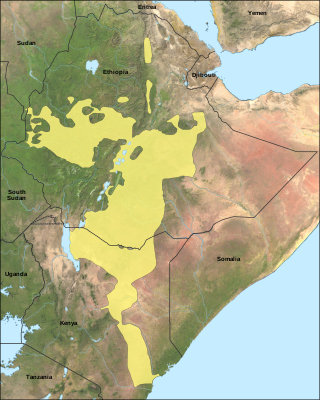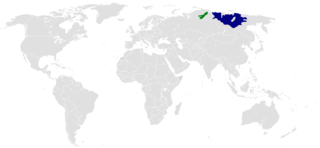The Finnish language is spoken by the majority of the population in Finland and by ethnic Finns elsewhere. Unlike the languages spoken in neighbouring countries, such as Swedish and Norwegian, which are North Germanic languages, or Russian, which is a Slavic language, Finnish is a Uralic language of the Finnic languages group. Typologically, Finnish is agglutinative. As in some other Uralic languages, Finnish has vowel harmony, and like other Finnic languages, it has consonant gradation.

Oromo, historically also called Galla, is an Afroasiatic language that belongs to the Cushitic branch. It is native to the Ethiopian state of Oromia and Northern Kenya and is spoken predominantly by the Oromo people and neighboring ethnic groups in the Horn of Africa. It is used as a lingua franca particularly in the Oromia Region and northeastern Kenya.

The Mari language, formerly known as the Cheremiss language, spoken by approximately 400,000 people, belongs to the Uralic language family. It is spoken primarily in the Mari Republic of the Russian Federation as well as in the area along the Vyatka river basin and eastwards to the Urals. Mari speakers, known as the Mari, are found also in the Tatarstan, Bashkortostan, Udmurtia, and Perm regions.

Southern or South Sámi is the southwesternmost of the Sámi languages, and is spoken in Norway and Sweden. It is an endangered language; the strongholds of this language are the municipalities of Snåsa, Røyrvik, Røros and Hattfjelldal in Norway. Of the approximately 2000 Southern Sami, only about 500 still speak fluent Southern Sami. This language belongs to the Saamic group within the Uralic language family.

Northern or North Sámi is the most widely spoken of all Sámi languages. The area where Northern Sámi is spoken covers the northern parts of Norway, Sweden and Finland. The number of Northern Sámi speakers is estimated to be somewhere between 15,000 and 25,000. About 2,000 of these live in Finland and between 5,000 and 6,000 in Sweden, with the remaining portions being in Norway.

Eastern Pomo, also known as Clear Lake Pomo, is a nearly extinct Pomoan language spoken around Clear Lake in Lake County, California by one of the Pomo peoples.
Ukrainian grammar is complex and characterised by a high degree of inflection, moreover it has a relatively free word order, although the dominant arrangement is subject–verb–object (SVO). Ukrainian grammar describes its phonological, morphological, and syntactic rules. Ukrainian has seven grammatical cases and two numbers for its nominal declension and two aspects, three tenses, three moods, and two voices for its verbal conjugation. Adjectives agree in number, gender, and case with their nouns.
The grammar of the Marathi language shares similarities with other modern Indo-Aryan languages such as Odia, Gujarati or Punjabi. The first modern book exclusively about the grammar of Marathi was printed in 1805 by Willam Carey.
Dirasha is a member of the Cushitic branch of the Afro-Asiatic family. It is spoken in the Omo region of Ethiopia, in the hills west of Lake Chamo, around the town of Gidole.
Lau (Law) is a Jukunoid language of Lau LGA, Taraba State, Nigeria. Lau speakers claim that their language is mutually intelligible with the Jukunoid language varieties spoken in Kunini, Bandawa, and Jeshi. They also live alongside the Central Sudanic-speaking Laka, who live in Laka ward of Lau LGA.
Ugaritic is an extinct Northwest Semitic language. This article describes the grammar of the Ugaritic language. For more information regarding the Ugaritic language in general, see Ugaritic language.

Yakutyə-KOOT, also known as Yakutian, Sakha, Saqa or Saxa, is a Turkic language belonging to Siberian Turkic branch and spoken by around 450,000 native speakers, primarily the ethnic Yakuts and one of the official languages of Sakha (Yakutia), a federal republic in the Russian Federation.
The grammar of the West Frisian language, a West Germanic language spoken mostly in the province of Friesland (Fryslân) in the north of the Netherlands, is similar to other West Germanic languages, most notably Dutch. West Frisian is more analytic than its ancestor language Old Frisian, largely abandoning the latter's case system. It features two genders and inflects nouns in the singular and plural numbers.
In Ancient Greek, all nouns are classified according to grammatical gender and are used in a number. According to their function in a sentence, their form changes to one of the five cases. The set of forms that a noun will take for each case and number is determined by the declension that it follows.
This article deals with the grammar of the Udmurt language.

Tundra Nenets is a Uralic language spoken in European Russia and North-Western Siberia. It is the largest and best-preserved language in the Samoyedic group.
This article deals with the grammar of the Komi language of the northeastern European part of Russia
Telugu is an agglutinative language with person, tense, case and number being inflected on the end of nouns and verbs. Its word order is usually subject-object-verb, with the direct object following the indirect object. The grammatical function of the words are marked by suffixes that indicate case and postpositions that follow the oblique stem. It is also head-final and a pro-drop language.
Konda-Dora, also known simply as Konda or Kubi, is a Dravidian language spoken in India. It is spoken by the scheduled tribe of the Konda-Dora, who mostly live in the districts of Vizianagaram, Srikakulam, and East Godavari in Andhra Pradesh, and the Koraput district in Odisha.
Turkmen grammar is the grammar of the Turkmen language, whose dialectal variants are spoken in Turkmenistan, Iran, Afghanistan, Russia, China, Uzbekistan, Tajikistan and others. Turkmen grammar, as described in this article, is the grammar of standard Turkmen as spoken and written by Turkmen people in Turkmenistan.






